This article was medically reviewed by Victor Catania, MD. Dr. Catania is a board certified Family Medicine Physician in Pennsylvania. He received his MD from the Medical University of the Americas in 2012 and completed his residency in Family Medicine at the Robert Packer Hospital. He is a member of the American Board of Family Medicine.
There are 14 references cited in this article, which can be found at the bottom of the page.
wikiHow marks an article as reader-approved once it receives enough positive feedback. This article has 11 testimonials from our readers, earning it our reader-approved status.
This article has been viewed 360,743 times.
Most small wounds, such as cuts and scrapes, can be easily treated at home. However, if you have a more serious wound or an infection, you may need medical attention to make sure it heals properly.
Steps
Treating Minor Wounds at Home
-
1Apply pressure to the wound to stop the bleeding. Wash your hands and then use a clean bandage or cloth to press firmly on the wound. Washing your hands will prevent you from transferring bacteria from your hands to the wound. The pressure will help slow the bleeding and promote clotting.[1]
- If the wound is on an arm, hand, leg, or foot, you can also slow the bleeding by raising it above your heart. For an arm or hand, you can hold it in the air. For a leg or foot, you will need to lie in bed and prop your leg up on a pile of pillows.
-
2Clean the wound. Rinse it with clean water. This will help to remove dirt and other particles that might cause an infection. Wash the skin around the wound with soap and a clean washcloth. Gently pat the wound and surrounding tissues dry.[2]
- If running water is not able to remove all of the debris from the wound, you may need to remove it with tweezers. Wash and then sterilize the tweezers with rubbing alcohol before touching them to the wound. Then gently remove any foreign particles embedded in the wound. If you cannot remove them all, go to the emergency room and have a doctor help you.
- If the wound has an object embedded in it, do not remove it. Instead, go to the doctor so that it can be removed safely without causing additional damage.[3]
- Do not wipe the wound with a cotton ball that might leave pieces of material stuck in the wound. This increases the risk of infection and may complicate healing.
Advertisement -
3Prevent infection with a topical antibiotic. After you have stopped the bleeding and cleaned the wound, apply an antibiotic cream to protect it from infection. You can purchase antibiotic creams and ointments such as Neosporin or Polysporin over-the-counter at your local pharmacy.[4] Use these ointments for one to two days.
- Always read and follow the instructions on the packaging. If you are pregnant, nursing, or treating a child, consult your doctor before using any medications.
- Do not apply an antiseptic disinfectant like alcohol or hydrogen peroxide. This can harm the tissues and make it take longer to heal.[5]
-
4Cover the wound with a bandage. This will prevent bacteria and dirt from entering the wound. Depending upon where the wound is located, a simple adhesive bandage may be sufficient. If the wound is larger or located near a joint, you may need to wrap it so that the covering will stay in place.[6]
- Do not wrap so tightly that you cut off the circulation.
- Change the bandage daily to prevent infection. If it becomes wet or dirty, change it promptly.
- Use waterproof bandages or wrap plastic wrap over your bandages when you shower to keep them dry.
-
5Monitor the wound to make sure it does not get infected. If it shows signs of infection, go to the emergency room. Signs to watch for include:[7]
- Increasing pain over time
- Warmth
- Swelling
- Redness
- Pus leaking from the wound
- Fever
Getting Medical Care
-
1Go to the emergency room if you have a serious wound. Do not try to drive yourself if you have just suffered a severe wound. Have someone drive you or call emergency medical responders. You need professional medical care if you have a wound that is bleeding severely or may leave you permanently disabled if it does not heal properly. This includes:[8]
- Cut arteries. If you are bleeding bright red blood which is pumped out of your wound each time your heart beats, call emergency medical responders. It is important that you receive care before you lose too much blood.
- Bleeding that does not stop after a few minutes of pressure. This may occur if you have a severe, deep cut. If can also occur if you have a blood disorder or are on medication that prevents your blood from clotting.
- Wounds where you cannot move or feel a body part. This may be indicative of a deeper injury to the bone or tendons.
- Wounds with a foreign object stuck inside. Common examples include glass, shrapnel, or stones. In this case a doctor will need to remove the objects and prevent infection.
- Long jagged cuts that are difficult to heal. If the cut is larger than about two inches, you may need stitches to help it close.
- Wounds to the face. Facial wounds require expert care to prevent scarring.
- Wounds that have a high risk of infection. This includes wounds that are contaminated with feces, bodily fluids (including saliva from animal or human bites), or soil.
-
2Get medical treatment for your wound. The care that your doctor recommends will likely vary based on whether it is infected. If it is not infected the wound will be cleaned and closed. Closing the wound quickly will help prevent scarring.[9] There are several techniques the doctor may use to close the wound:[10]
- Stitches. Wounds longer than about 2 ½ inches may be sewn closed with sterile thread. The stitches may be taken out by a doctor five to seven days later for small incisions, seven to 14 for larger wounds. Or, if your doctor feels it is appropriate, she may use thread where the stitches will dissolve after a few weeks as the wound heals.[11] Never remove your stitches yourself. You may cause an injury or infection to the site of the wound.
- Tissue adhesive glue. This substance would be applied to the edges of the wound while it is held together. As it dries it will seal the wound shut. The glue will come off by itself after about a week.
- Butterfly stitches. These are not actually stitches. Instead they are sticky strips that hold the wound closed. The doctor will remove them after the wound heals. Do not remove them yourself.
-
3Let your doctor treat an infected wound. If your wound is infected the doctor will treat the infection before closing the wound. If it is closed while it is still infected, this will seal the infection in and may cause it to spread. Your doctor may:[12]
- Swab the infection so the pathogen can be studied and identified. This can help determine the best course of treatment.[13]
- Clean the wound and pack it with a dressing that will prevent it from closing.
- Give you antibiotics to eliminate the infection.
- Ask you to return after several days so the doctor can evaluate whether the infection has been successfully treated. If so, the doctor will then close the wound.
-
4Get a tetanus vaccine. Your doctor may want you to get a tetanus vaccine if the wound is deep or has dirt in it and you have not had one in the past five years.[14]
- Tetanus is a bacterial infection. It is also called “lockjaw” because it can cause the muscles of the jaw and neck to contract. It can also cause breathing problems and can be fatal.
- There is no cure, so the best prevention is staying up to date on your vaccines.
-
5Go to a wound care center if you have a non-healing wound. Non-healing wounds are wounds that have not started to heal after two weeks or have not finished healing after six weeks. Common types of wounds that are difficult to heal include pressure sores, surgical wounds, radiation sores, and wounds resulting from diabetes, lack of blood flow, or swollen legs, which often occur in the foot.[15] At a wound care center you will have access to:[16]
- Nurses, doctors, and physical therapists who will teach you to clean your wound properly and do exercises to maintain the blood flow.
- Specialized therapies to remove dead tissue. This may include cutting it away, using a whirlpool or syringe to wash it away, applying chemicals to dissolve the dead tissue, and using wet-to-dry dressings that dry on the wound and absorb dead tissue.
- Specialized procedures to promote healing include: compression stockings to improve blood flow, ultrasound to stimulate healing, artificial skins to protect wounds as they heal, removing fluid from the wound with negative pressure therapy, providing you with growth factors to promote healing, and using hyperbaric oxygen therapy to increase the blood supply to your tissues.
Expert Q&A
-
QuestionWhat if a cut at the back of my foot has been bleeding for over an hour?
 Jonas DeMuro, MDDr. DeMuro is a board certified Pediatric Critical Care Surgeon in New York. He received his MD from Stony Brook University School of Medicine in 1996. He completed his fellowship in Surgical Critical Care at North Shore-Long Island Jewish Health System and was a previous American College of Surgeons (ACS) Fellow.
Jonas DeMuro, MDDr. DeMuro is a board certified Pediatric Critical Care Surgeon in New York. He received his MD from Stony Brook University School of Medicine in 1996. He completed his fellowship in Surgical Critical Care at North Shore-Long Island Jewish Health System and was a previous American College of Surgeons (ACS) Fellow.
Board Certified Critical Care Surgeon Any cut that is deep and continues to bleed should be treated in the ER. It will likely require stitches for closure.
Any cut that is deep and continues to bleed should be treated in the ER. It will likely require stitches for closure.
References
- ↑ https://www.nhs.uk/conditions/cuts-and-grazes/
- ↑ https://www.nhs.uk/conditions/cuts-and-grazes/
- ↑ https://www.uofmhealth.org/health-library/tp22233spec
- ↑ https://www.fairview.org/Patient-Education/Articles/English/r/e/c/o/g/Recognizing_and_Treating_Wound_Infection_85329
- ↑ https://health.clevelandclinic.org/handling-injuries-from-small-cuts-to-serious-wounds/
- ↑ https://health.clevelandclinic.org/cover-wound-air/
- ↑ https://www.healthywa.wa.gov.au/Articles/U_Z/Wounds
- ↑ https://www.nhs.uk/conditions/cuts-and-grazes/
- ↑ https://www.aad.org/public/everyday-care/injured-skin/burns/wound-care-minimize-scars
- ↑ https://www.ncbi.nlm.nih.gov/books/NBK470598/
- ↑ https://www.nhs.uk/common-health-questions/accidents-first-aid-and-treatments/how-long-will-my-stitches-sutures-take-to-dissolve/
- ↑ https://www.aafp.org/afp/2002/0715/p315.html
- ↑ https://www.uofmhealth.org/health-library/hw5656
- ↑ https://www.uofmhealth.org/health-library/sig3065
- ↑ https://www.betterhealth.vic.gov.au/health/conditionsandtreatments/wounds-how-to-care-for-them
- ↑ https://medlineplus.gov/ency/patientinstructions/000739.htm
About This Article
To treat a wound, rinse it with clean water and wash the skin around it using soap and a clean washcloth. After you clean the wound, apply a topical antibiotic cream to it, to help prevent an infection. Cover the wound with a bandage so it's protected. Repeat the process every day, applying a clean bandage each day, until the wound has healed. You should also watch the wound for signs that it's infected, like swelling, redness, and pus. To learn more from our Physician co-author, such as when to seek medical attention, keep reading the article!








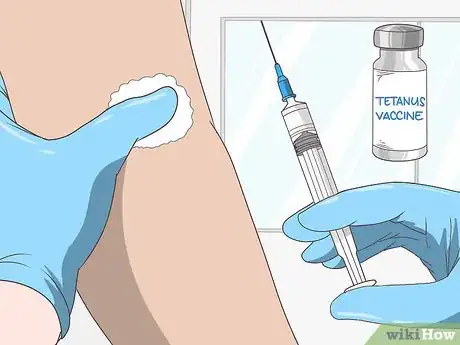



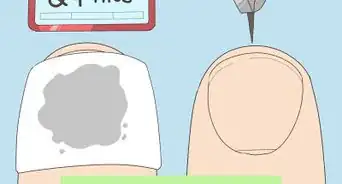
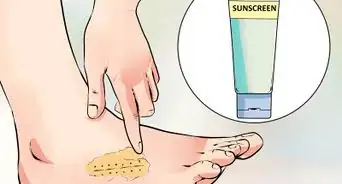

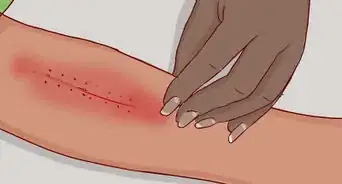

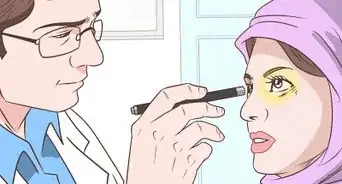

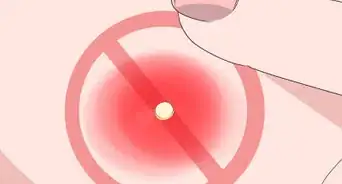
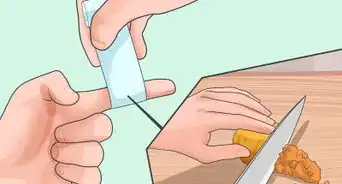
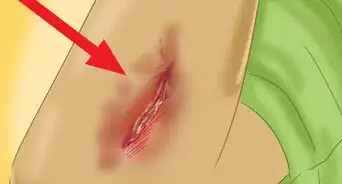












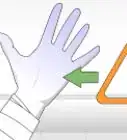
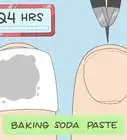



































Medical Disclaimer
The content of this article is not intended to be a substitute for professional medical advice, examination, diagnosis, or treatment. You should always contact your doctor or other qualified healthcare professional before starting, changing, or stopping any kind of health treatment.
Read More...